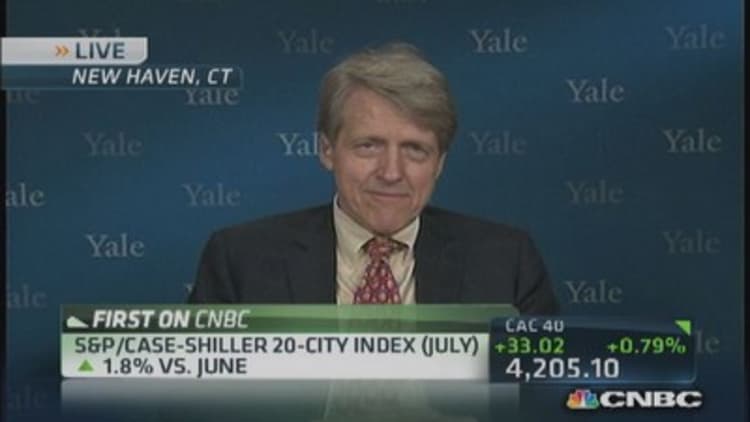Some of the nation's largest home builders are raising prices at a furious pace, even as prices for existing homes begin to moderate. While newly built homes have always sold at a premium to existing homes, the divide is widening.
"The big picture is that new-build house prices fell by less than existing house prices during the crash and have risen by more during the recovery," noted Paul Diggle at Capital Economics. He said builders will now have to slow their price growth faster than existing home sellers.
Existing home prices were up just over 12 percent annually in July, according to the latest S&P/Case-Shiller Home Price Index, which is a three-month running average. The average price of a newly built Lennar home jumped 16 percent annually in the third quarter, while the average price of those built by KB Home surged 23 percent.
(Read more: Single family home prices rise, but at less feverish pace)
"We continue to see long-term fundamental demand in the market driven by the significant shortfall of new single-family and multi-family homes built over the last five years," wrote Lennar's CEO Stuart Miller in the earnings release.

The average price of a Lennar home is $291,000, while the average price of all existing homes in August was $258,800, according to the National Association of Realtors. The price premium is much higher than historical norms, according to researchers at John Burns Real Estate Consulting. Robert Shiller said on CNBC's "Squawk Box" that some markets were "bubbly." Analyst Ivy Zelman disagrees.
"We believe that analyses that suggest new homes are either unaffordable or priced at an abnormal premium to existing homes are flawed," Zelman wrote in a note to investors last month. "In AZ, CA, FL and NV, we conclude that prices are still 15 percent lower than the 2006 peak, which excludes an adjustment for an increasing size of new homes and would be further compounded by seven years of inflation."
Existing home price gains decelerated in July on the Case-Shiller index, likely due to the sharp jump in mortgage rates, but the gains were still sizable and unlikely to abate much. That's due simply to lack of supply. The number of for-sale homes continues to drop across the nation.
(Read more: Map: Tracking the recovery)
While inventories improved slightly in August on a national basis, up 0.4 percent month-to-month, they are still down 6.3 percent from a year ago, according to the National Association of Realtors.
While home sales were higher in August, the Realtors said it was, "the last hurrah," as several indicators showed buyer traffic slowed dramatically at the end of the summer.
"The sharpest falloff in the HousingPulse Homebuyer Traffic Indexes was seen among current homeowners, the largest group of home purchasers in this year's housing market. The first-time homebuyer group also saw a decline in its traffic index," according to a new report from Campbell/Inside Mortgage Finance.
The fall and winter months are traditionally the slowest in the housing business, and weaker demand will affect prices. Sales of newly built homes have not exactly been gangbusters, and new orders at both Lennar and KB Home were weaker than expected. Make no mistake, underlying demand exists, it's just a question of when it emerges in force.
So far, even weak demand has pushed prices higher, again, due to historically low supply.
(Read more: Real estate's new frontier: Crowdfunding)
"Construction of single-family homes has been depressed since late 2007, while the U.S. population has increased by more than 12 million over that time," said economist Patrick Newport of IHS Global Insight. "Since underlying demand is, by our estimate, running at a rate nearly twice that of housing completions, the shortages are likely to get larger before getting smaller."
This means that home-price gains, as measured by the Case-Shiller indexes, are likely to remain strong for some time, even if they retreat some from the current pace."
—By CNBC's Diana Olick. Follow her on Twitter @Diana_Olick.
Questions?Comments? facebook.com/DianaOlickCNBC.


